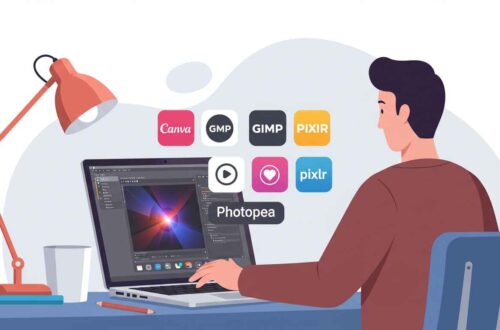Lighting is the heart of portrait photography. It can completely transform how your subject looks — soft, dramatic, warm, or mysterious. Even with an average camera, good lighting can make your portraits look professional and emotional.
In this guide, you’ll learn how to use lighting effectively for portraits — whether you’re shooting indoors or outdoors, with natural light or artificial sources. Let’s make your photos glow beautifully!
Why Lighting Matters in Portrait Photography
Light defines shape, texture, and mood. It brings your subject to life by creating shadows, highlights, and contrast.
In simple words:
Lighting decides how your audience feels about your photo.
Poor lighting can make a face look flat or harsh, while proper lighting can enhance natural beauty and create depth.
Great photographers don’t just “find” light — they shape it to tell a story.
The Three Main Types of Light
Before learning setups, understand the three basic light types used in portraits:
- Key Light – The main light that illuminates your subject.
- Fill Light – A softer light that reduces harsh shadows.
- Back Light (Rim Light) – Placed behind to create separation from the background.
When you combine these smartly, you create a balanced and flattering portrait.
1. Natural Light Portraits
Natural light (from the sun) is one of the easiest and most beautiful sources you can use. It’s soft, free, and available everywhere.
🔹 Best Times to Shoot
- Golden Hour: Shortly after sunrise or before sunset — gives a warm, soft, glowing light.
- Blue Hour: Just before sunrise or after sunset — gives a cool, cinematic tone.
- Cloudy Days: Perfect for even, diffused light without harsh shadows.
🔹 Tips for Using Natural Light
- Avoid direct midday sunlight — it causes hard shadows.
- Use shade (under a tree or near a wall) for softer lighting.
- Try facing your subject toward a window or the sun for even illumination.
- Use a reflector (or even white cardboard) to bounce light and fill shadows.
📸 Pro Tip: When shooting indoors, place your subject near a large window and use sheer curtains to diffuse sunlight for a soft look.
2. Artificial Lighting (Studio or DIY)
Artificial light gives you full control over brightness, direction, and tone. Perfect when shooting indoors or at night.
🔹 Common Light Sources
- Ring Light – Creates even, flattering light with circular eye reflections.
- Softbox / Umbrella Light – Spreads soft, diffused light, ideal for faces.
- LED Panels – Adjustable color and brightness, great for flexible setups.
🔹 Key Setup Styles
🕯️ a) Rembrandt Lighting
Named after the painter Rembrandt, this style uses a small triangle of light on one cheek.
- Place your light 45° to the side and slightly above your subject.
- It adds drama and depth — perfect for artistic portraits.
💫 b) Butterfly Lighting
Named for the butterfly-shaped shadow under the nose.
- Place your light directly above and in front of your subject.
- Works well for glamour or beauty shots.
🌙 c) Split Lighting
One half of the face is lit, the other in shadow.
- Place your key light directly to one side (90°).
- Creates a mysterious, moody feel.
🌄 d) Loop Lighting
A small shadow loops under the nose, slightly to one side.
- Place the light at 30–45° angle from your subject.
- Great for flattering, everyday portraits.
3. Mix Natural and Artificial Light
You can combine window light with LED or fill lights to create balance.
Example:
- Use window light as your key light.
- Add a ring light to soften shadows.
- Use a small lamp or candle behind the subject for warmth and depth.
Mixed lighting adds texture and a cinematic vibe when balanced correctly.
4. Understanding Light Direction
The direction of your light changes everything:
| Lighting Direction | Description | Mood / Effect |
|---|---|---|
| Front Light | Light from front of subject | Clear, flat, even skin tone |
| Side Light | Light from left or right | Adds depth and texture |
| Back Light | Light behind subject | Creates glow or silhouette |
| Top Light | Light from above | Dramatic, high contrast |
| Bottom Light | Light from below | Horror or creative effect |
Try different angles to see how your subject’s face reacts — small changes can produce big differences.
5. Control the Shadows
Shadows are not your enemy — they add emotion and shape. The key is to control, not eliminate, them.
Ways to control shadows:
- Use reflectors or fill lights to soften harsh shadows.
- Adjust the distance of your light source — closer = softer shadows.
- Use white surfaces (like walls) to bounce light naturally.
📸 Pro Tip: Place a silver or gold reflector under the face to bounce light upward — it reduces dark circles and adds glow.
6. Choose the Right Background
Lighting doesn’t only affect your subject — it affects the entire scene.
- A bright background works best with soft, diffused light.
- A dark background enhances contrast and depth.
- Avoid reflective surfaces that may cause glare or color tints.
Try matching the background tone to your lighting mood — warm light for cozy portraits, cool tones for dramatic styles.
7. Light Color and Temperature
Light has “color temperature,” measured in Kelvins (K):
| Type of Light | Color | Temperature |
|---|---|---|
| Candle / Lamp | Warm yellow | 2500–3000K |
| Sunrise / Sunset | Golden | 3000–4000K |
| Noon Sunlight | Neutral white | 5000–5500K |
| Cloudy Sky | Cool blue | 6000–7000K |
To keep your portraits natural, adjust your white balance based on the light source.
You can also experiment with colored gels to add mood — for example, orange for warmth, blue for calm, or pink for fantasy portraits.
8. Don’t Forget Catchlights
“Catchlights” are those small white reflections in your subject’s eyes. They bring life and sparkle to a portrait.
They usually appear naturally when your light source faces your subject, but you can adjust the position slightly to make them brighter.
📸 Pro Tip: If the eyes look dull, move the light slightly higher or closer — that’s usually all it takes to bring them alive.
9. Experiment with Creative Lighting
Once you master basics, try creative effects:
- Backlighting with haze or smoke for dreamy looks.
- Colored lights for futuristic portraits.
- Silhouettes during sunset for drama.
- Low-key lighting (mostly dark) for cinematic portraits.
- High-key lighting (bright and soft) for clean, airy looks.
Play with light direction, intensity, and color — creativity often starts when you break rules intentionally.
10. Common Lighting Mistakes to Avoid
❌ Using only overhead light (creates harsh shadows)
❌ Shooting in harsh noon sunlight without shade
❌ Forgetting to check shadows on the face or background
❌ Ignoring the color of your light sources
❌ Using unflattering angles (light from below rarely works)
Fix these, and your portraits will instantly look more professional.
Quick Lighting Checklist for Portraits
- Choose your light source (natural / artificial)
- Position your key and fill light properly
- Adjust brightness to avoid overexposure
- Watch for shadows on the face and neck
- Keep catchlights visible in the eyes
- Balance warm and cool tones
- Review test shots before final capture
Final Thoughts
Lighting is what separates a good photo from a masterpiece. Once you learn how to shape, balance, and control it, you’ll be able to create portraits that truly stand out.
Don’t worry about having fancy studio gear — even a window, a desk lamp, or sunlight can help you achieve magical results when used correctly.
So next time you take a portrait, think about your light direction, mood, and shadows — and watch how your images transform into something extraordinary.





